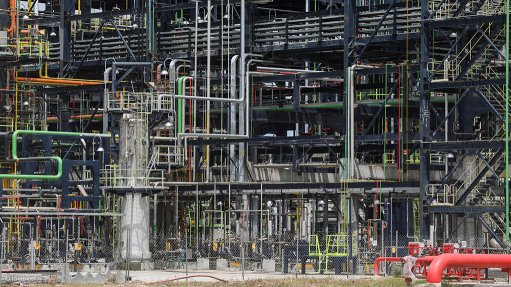Economic Reconstruction and Recovery Plan presents opportunity to build a better economy, says Saice
The Economic Reconstruction and Recovery Plan (ERRP) tabled by President Cyril Ramaphosa in October, provides an opportunity to build a better structured economy, reports South African Institution of Civil Engineering (Saice) CEO Vishaal Lutchman.
Following Ramaphosa’s announcement of the plan, Finance Minister Tito Mboweni also focused on it when he delivered the Medium-Term Budget Policy Statement (MTBPS) on October 28, with the plan serving as the undertone to getting South Africa back on track, in terms of financial stability.
Saice hosted a panel discussion on the economics of infrastructure on October 29 with the aim of establishing how government and business can work together to achieve the goals set out in the plan.
In a statement issued after the event, Lutchman says that, while the term “reconstruction” is usually associated with fixing something that is broken, fixing South Africa’s economy will be a path for growth, development and job creation.
Quoting the National Development Plan 2030, he says that what South Africa does, and how the country does it, is just as important as what South Africa wants to achieve.
As an example, Lutchman says civil engineers play a crucial role in this recovery and that, from a Saice perspective, the organisation wants to be a part of the reconstruction. “We want to rebuild our infrastructure, our society and our nation, but we are finding it hard to connect skilled individuals with the work at hand.”
In addition, he asks for input about Mboweni’s MTBPS with regard to putting all South Africa’s efforts into implementing the ERRP, which Lutchman says can accelerate economic growth to 3% or more.
“This will secure fiscal sustainability and build this economy better than before.”
Another panellist who participated in the Saice discussion, Cannon Asset Managers CEO and founder and GIBS professor Adrian Saville, says that, from a macroeconomic perspective, government policy has, since the 1990s, aimed for 5% growth.
“However, in 20 years, our delivery has been lower, with deep social and economic impacts. Covid-19 has certainly played a part in this, but we cannot actually attribute our current state to the pandemic alone.”
He says the moderated 3% growth could be achievable through gross domestic fixed investment (GDFI), but that GDFI is challenged by South Africa’s savings rate having fallen from 15% to 10% since the pandemic started.
In terms of the ERRP, panellist National Planning Commission commissioner Miriam Altman says there is no doubt that the plan’s infrastructure focus is the “right one”.
She notes that, “we all agree on it, and we want to do it, so what is going wrong? We cannot just talk about the list of projects we want implemented. The capacity to deliver is the number one thing we need to be talking about. A 3% increase is somewhat ambitious, but if we focus on capacity, we can create the conditions for growth. We have the power to change our gross domestic product ratio.”
In response, Lutchman comments that, often, development plans feel like “teasers” with false hope of development.
During the discussion, he had asked panellists what would need to happen to bring plans to reality, to which they responded that a more modest goal would set South Africa up to succeed and would have positive knock-on effects to get the plan into action.
“Three per cent is not a great number – government may be overestimating,” says Altman, adding, however, that it is still within South Africa’s power to achieve it by focussing on a few top priority projects.
She urges stakeholders to ensure the barriers to project implementation are attended to.
“We need distributed capability, down to the ground, to be able to implement. We need to strengthen municipal capabilities and key State-owned entities that deliver infrastructure. That is the only way we are going to do this.”
Comments
Press Office
Announcements
What's On
Subscribe to improve your user experience...
Option 1 (equivalent of R125 a month):
Receive a weekly copy of Creamer Media's Engineering News & Mining Weekly magazine
(print copy for those in South Africa and e-magazine for those outside of South Africa)
Receive daily email newsletters
Access to full search results
Access archive of magazine back copies
Access to Projects in Progress
Access to ONE Research Report of your choice in PDF format
Option 2 (equivalent of R375 a month):
All benefits from Option 1
PLUS
Access to Creamer Media's Research Channel Africa for ALL Research Reports, in PDF format, on various industrial and mining sectors
including Electricity; Water; Energy Transition; Hydrogen; Roads, Rail and Ports; Coal; Gold; Platinum; Battery Metals; etc.
Already a subscriber?
Forgotten your password?
Receive weekly copy of Creamer Media's Engineering News & Mining Weekly magazine (print copy for those in South Africa and e-magazine for those outside of South Africa)
➕
Recieve daily email newsletters
➕
Access to full search results
➕
Access archive of magazine back copies
➕
Access to Projects in Progress
➕
Access to ONE Research Report of your choice in PDF format
RESEARCH CHANNEL AFRICA
R4500 (equivalent of R375 a month)
SUBSCRIBEAll benefits from Option 1
➕
Access to Creamer Media's Research Channel Africa for ALL Research Reports on various industrial and mining sectors, in PDF format, including on:
Electricity
➕
Water
➕
Energy Transition
➕
Hydrogen
➕
Roads, Rail and Ports
➕
Coal
➕
Gold
➕
Platinum
➕
Battery Metals
➕
etc.
Receive all benefits from Option 1 or Option 2 delivered to numerous people at your company
➕
Multiple User names and Passwords for simultaneous log-ins
➕
Intranet integration access to all in your organisation


















